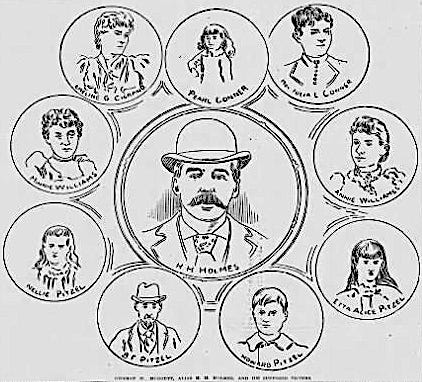A Killer Reading List
True tales of modern monsters, from Jack the Ripper to the Long Island Serial Killer
Welcome back to Culture Club, a feature where David and I write about what we’ve been reading, watching, playing, and listening to, for paid subscribers. Please enjoy this free preview, and consider upgrading to support two struggling journalists at once! — Talia
When I saw “Gilgo Beach” trending this week, it didn’t really ring any bells; though the name was vaguely familiar, the fact that I’d visited the beach almost a dozen years ago had escaped my memory. But when I finally clicked on a link, and saw that police had apprehended the so-called “Long Island Serial Killer,” it all came back. On December 13, 2011, I was at Gilgo Beach, on the South Shore of Long Island, where the remains of Shannan Gilbert had been recently been discovered, a year and a half after she’d originally gone missing. Beginning with that seemingly unique disappearance in May 2011, authorities searching the area went on to uncover the remains of four others: Melissa Barthelemy, Maureen Brainard-Barnes, Megan Waterman, and Amber Costello. The families of the victims had gathered at Gilgo Beach for a vigil on the anniversary of that first discovery. I was there to report on the crime.
The arrest on Thursday of Rex Heuermann — the Long Island architect who was charged with the murders of Barthelemy, Waterman, and Costello — surprised me in some ways. He wasn’t on anyone’s radar when I was writing about the case, though there were plenty of other suspects. But he fit the profile that authorities had laid out. As I wrote in the February, 2012 issue of Maxim:
Profilers, both armchair and expert, had a field day trying to paint a portrait of the killer. The shared location of the remains indicates that he’s both brazen and meticulous. His knowledge of the region suggests a local, but the phone calls to Melissa Barthelemy’s sister were traced to Manhattan. His ability to secure the victims’ trust indicates that he’s charming, but the very nature of the crimes is a clear sign of acute sadism. The burlap bags point to a landscaper or clam digger, but the killer’s skill in avoiding detection and capture has led some to speculate that he’s a member of law enforcement.
As we learned this week, Heuermann was a lifelong resident of Long Island, who worked in Manhattan. He was meticulously detail-oriented in his professional life, and spent his free time building furniture at home. He was described by colleagues as outgoing, but by neighbors as creepy. In hindsight, he fit the profile remarkably well.
Given Heuermann’s arrest, I thought I’d just re-publish my feature from 2012, but if I’m being completely honest, it’s not very good. Feel free to read it, but Robert Kolker wrote a far more authoritative piece on the case for New York magazine … and then literally wrote the book on it. Instead, I went down the inevitable serial killer rabbit hole. Now that I’ve resurfaced, there’s plenty of grisly material to share, an archival murderers row of some of the most notorious killers in history. I kick things off in the late 19th century, with contemporary newspaper accounts of the Jack the Ripper and H. H. Holmes cases. And if those tales are a bit too dusty for your taste, you’ll also find most of your favorite modern monsters here: Ed Gein and John Wayne Gacy; Ted Bundy and Son of Sam; the Atlanta Child Killer and the Green River Killer and the Bus Stop Killer and the Long Island Serial Killer.
And now he’s off the streets. At that Gilgo Beach vigil, I spoke with Gus Colleti, a local resident who was the last person to see Shannan Gilbert alive. “They’re going to find more bodies,” he told me, “because the thing about serial killers is they don’t quit killing. And he’s still out there.” It took over a decade, but that’s no longer true.
Jack the Ripper: The Tragedies at Aldgate and Whitechapel
(Article text)
The Daily Telegraph, Oct 2, 1888
A belief is gaining ground that the murderer is not a frequenter of common lodging-houses, but he occupies a single room, or perhaps finds refuge in an empty warehouse. He is supposed to make his home somewhere between Middlesex-street and Brick-lane…
According to one he is a thick-set, close-shaven man, with a short coat and dark trousers; another states that he is a pretty tall man, with short dark whiskers and beard; a third speaks of him as shortish, with light whiskers; sometimes he wears a dark ulster, and at others a checked one; now he is well-dressed, and again shabby-genteel; and altogether the descriptions given are so confusing that they afford no guide to any officer. It would seem that in Whitechapel, Stepney, and Spitalfields there are several petty ruffians who levy blackmail upon these women under threats of mutilation, and, after parting with any sum they may possess, the wretched females tell either a constable or some of their neighbours that they have had a narrow escape from the murderer, and give a description of him. Fragmentary stories of this kind form the major portion of the information the police have to work up, the criminal himself having left nothing behind to assist in his identification. Up to the present about half-a-dozen people have been arrested and released.
H. H. Holmes: Bones of Slain: Holmes Fell Crimes are Revealed to the Police
The Chicago Chronicle, July 28, 1895
That the building at the corner of Wallace and Sixty-third streets was a charnel house, and that H. H. Holmes used the dark rooms and secret passages which he himself designed to commit and conceal murders almost innumerable was conclusively proved last night by a man who brought the skull of one of the butcher’s female victims to Inspector Fitzpatrick at the Central police sta-tion.
The story that this man told the inspector almost surpasses human credulity. Its purport is that Holmes. after dispatching his victims, had their skeletons mounted for preservation. Whether he did this to perpetuate the memory of his horrid crimes, or whether, as in everything else he did, he was actuated by motives of financial gain, can only be conjectured.
Ed Gein: “House of Horror Stuns the Nation”
Francis Miller & Frank Scherschel
Life, December 2, 1957
Hanging by the feet in Gein’s summer kitchen the sheriff found Mrs. Worden’s body, headless and eviscerated. That was not all. There were 10 other human heads — one of them Mary Hogan’s — some neatly wrapped in cellophane, and a chair upholstered in human skin. Now Plainfield knew that for years it had been living with horror that seemed the worse for having been unsuspected. The revelations made front-page news all across the U.S. and gave Americans everywhere a grim awareness that what had happened in an obscure Wisconsin town might have happened anywhere.
Ed Gein stood revealed as an incredible murderer. A Chicago psychiatrist called him “one of the most dramatic human beings ever to confront society.” Yet the full measure of his evil might remain forever a mystery. He admitted only two killings and said he stole the other heads from graves. But there were strong and spine-chilling doubts about this. As his mind’s tortured workings began to be understood, his neighbors realized Ed Gein had been giving them clues all along.
Keep reading with a 7-day free trial
Subscribe to The Sword and the Sandwich to keep reading this post and get 7 days of free access to the full post archives.








